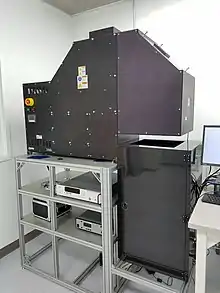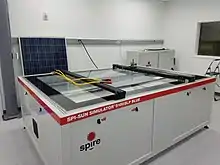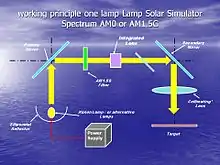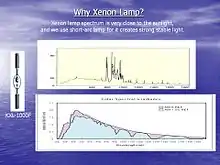Solar simulator
A solar simulator (also artificial sun) is a device that provides illumination approximating natural sunlight. The purpose of the solar simulator is to provide a controllable indoor test facility under laboratory conditions, used for the testing of solar cells, sun screen, plastics, and other materials and devices.

Classification
The IEC 60904-9 Edition2 and ASTM E927-10 standards [1] are a common specification for solar simulators used for photovoltaic testing. The light from a solar simulator is controlled in three dimensions:
- spectral content
- spatial uniformity
- temporal stability
Each dimension is classified in one of three classes: A, B, or C. The specifications required for each class are defined in Table 1 below. A solar simulator meeting class A specifications in all three dimensions is referred to as a Class A solar simulator, or sometimes a Class AAA (referring to each of the dimensions in the order listed above).[1]
| Classification | Spectral Match (each interval) | Irradiance Spatial Non-Uniformity | Temporal Instability |
|---|---|---|---|
| Class A | 0.75–1.25 | 2% | 2% |
| Class B | 0.6–1.4 | 5% | 5% |
| Class C | 0.4–2.0 | 10% | 10% |
The solar simulation spectrum is further specified via the integrated irradiance across several wavelength intervals. The percentage of total irradiance is shown below in Table 2 for the standard terrestrial spectra of AM1.5G and AM1.5D, and the extraterrestrial spectrum, AM0.
| Wavelength Interval [nm] | AM1.5D | AM1.5G | AM0 |
|---|---|---|---|
| 300–400 | no spec | no spec | 8.0% |
| 400–500 | 16.9% | 18.4% | 16.4% |
| 500–600 | 19.7% | 19.9% | 16.3% |
| 600–700 | 18.5% | 18.4% | 13.9% |
| 700–800 | 15.2% | 14.9% | 11.2% |
| 800–900 | 12.9% | 12.5% | 9.0% |
| 900–1100 | 16.8% | 15.9% | 13.1% |
| 1100–1400 | no spec | no spec | 12.2% |
These specifications were primarily intended for silicon photovoltaics, and hence the spectral range over which the intervals were defined was limited mainly to the absorption region of silicon. While this definition is also adequate for several other photovoltaic technologies, including thin film solar cells constructed from CdTe or CIGS, it is not sufficient for the emerging sub-field of concentrated photovoltaics using high-efficiency III-V semiconductor multi-junction solar cells due to their wider absorption bandwidth of 300–1800 nm.
Types of solar simulators

Solar simulators can be divided into three broad categories: continuous, flashed, and pulsed. The first type is a familiar form of light source in which illumination is continuous in time. The specifications discussed in the previous section most directly relate to this type of solar simulator. This category is most often used for low intensity testing, from less than 1 sun up to several suns. In this context, 1 sun is typically defined as the nominal full sunlight intensity on a bright clear day on Earth, which measures 1000 W/m2. Continuous light solar simulators may have several different lamp types combined (e.g. an arc source and one or more halogen lamps) to extend the spectrum far into the infrared. [2] Examples of low-intensity and high-intensity continuous solar simulators are available from Solar Light Company, Inc. (inventor of the original solar simulator in 1967,) Atonometrics,[3] Eternal Sun,[4] TS-Space Systems,[5] WACOM,[6] Newport Oriel,[7] Sciencetech,[8] Spectrolab,[9] Photo Emission Tech,[10] Abet Technologies,[11] infinityPV [12]

The second type of solar simulator is the flashed simulator which is qualitatively similar to flash photography and use flash tubes. With typical durations of several milliseconds, very high intensities of up to several thousand suns are possible. This type of equipment is often used to prevent unnecessary heat build-up in the device under test. However, due to the rapid heating and cooling of the lamp, the intensity and light spectrum are inherently transient, making repeated reliable testing more technically challenging. The temporal stability dimension of the standard does not directly apply to this category of solar simulators, although it can be replaced by an analogous shot-to-shot repeatability specification.
The third type of solar simulator is the pulsed simulator, which uses a shutter to quickly block or unblock the light from a continuous source. This category is a compromise between the continuous and flash, having the disadvantage of the high power usage and relatively low intensities of the continuous simulators, but advantage of stable output intensity and spectrum. The short illumination duration also provides the benefit of the low thermal loads of flashed simulators. Pulses are typically on the order of 100 milliseconds up to 800 milliseconds for special Xe Long Pulse Systems.
Types of lamps
Several types of lamps have been used as the light sources within solar simulators.

Xenon arc lamp: this is the most common type of lamp both for continuous and flashed solar simulators. These lamps offer high intensities and an unfiltered spectrum which matches reasonably well to sunlight. However, the Xe spectrum is also characterized by many undesirable sharp atomic transitional peaks, making the spectrum less desirable for some spectrally sensitive applications.
Metal Halide arc lamp: Primarily developed for use in film and television lighting where a high temporal stability and daylight colour match are required, metal halide arc lamps are also used in solar simulation.
QTH: quartz tungsten halogen lamps offer spectra which very closely match black body radiation, although typically with a lower color temperature than the sun.
LED: light-emitting diodes have recently been used in research laboratories to construct solar simulators, and may offer promise in the future for energy-efficient production of spectrally tailored artificial sunlight.
References
- "Specification for Solar Simulation for Photovoltaic Testing". 2010. doi:10.1520/E0927-10. Cite journal requires
|journal=(help) - "Tables for Reference Solar Spectral Irradiances: Direct Normal and Hemispherical on 37 Tilted Surface". 2008. doi:10.1520/G0173-03R08. Cite journal requires
|journal=(help) - Light Soaking Effects on Photovoltaic Modules (PDF) (Report). Atonometrics, Inc.
- Simulation-standard-and-AAA-rating (PDF) (Report). Eternal Sun.
- TS-Space Systems Unisim Solar Simulator (PDF) (Report). TS-Space Systems.
- WACOM Solar Simulator (PDF) (Report). WACOM.
- Oriel Solar Simulation (PDF) (Report). Newport.
- Sciencetech Solar Simulators (PDF) (Report). Sciencetech Inc.
- XT-30 Continuous Wave Solar Simulator (PDF) (Report). Spectrolab.
- A step by step guide to selecting the right Solar Simulator for your solar cell testing application (PDF) (Report). Photo Emission Tech.
- Abet Technologies Solar Simulator (PDF) (Report). Abet Technologies.
- infinityPV ISOSun solar simulator (PDF) (Report). infinityPV.